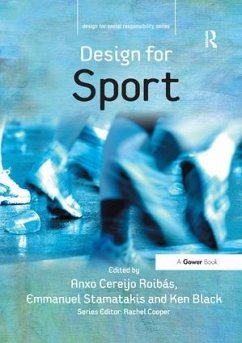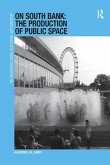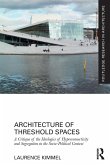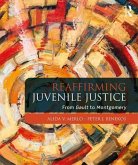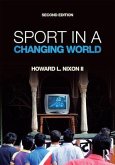- Broschiertes Buch
- Merkliste
- Auf die Merkliste
- Bewerten Bewerten
- Teilen
- Produkt teilen
- Produkterinnerung
- Produkterinnerung
Explores how design in its broad sense can contribute to make sport practice widespread in the general population as well as among disadvantaged and hard-to-reach groups. The authors discuss the impact and challenges of this process and present case studies about the design for sport . Design for Sport also examines how compelling user-centred design methodologies - such as participatory design techniques and the use of appropriate ethnographies - can be successfully applied in the process of sport design.
Andere Kunden interessierten sich auch für
![On South Bank: The Production of Public Space On South Bank: The Production of Public Space]() Alasdair J H JonesOn South Bank: The Production of Public Space68,99 €
Alasdair J H JonesOn South Bank: The Production of Public Space68,99 €![Architecture and Justice Architecture and Justice]() Jonathan SimonArchitecture and Justice70,99 €
Jonathan SimonArchitecture and Justice70,99 €![Architecture of Threshold Spaces Architecture of Threshold Spaces]() Laurence KimmelArchitecture of Threshold Spaces56,99 €
Laurence KimmelArchitecture of Threshold Spaces56,99 €![Reaffirming Juvenile Justice Reaffirming Juvenile Justice]() Alida V MerloReaffirming Juvenile Justice69,99 €
Alida V MerloReaffirming Juvenile Justice69,99 €![Sport in a Changing World Sport in a Changing World]() Howard Nixon IISport in a Changing World78,99 €
Howard Nixon IISport in a Changing World78,99 €![Global Ideologies and Urban Landscapes Global Ideologies and Urban Landscapes]() Global Ideologies and Urban Landscapes60,99 €
Global Ideologies and Urban Landscapes60,99 €![Environment and Society Environment and Society]() Erika CudworthEnvironment and Society69,99 €
Erika CudworthEnvironment and Society69,99 €-
-
-
Explores how design in its broad sense can contribute to make sport practice widespread in the general population as well as among disadvantaged and hard-to-reach groups. The authors discuss the impact and challenges of this process and present case studies about the design for sport . Design for Sport also examines how compelling user-centred design methodologies - such as participatory design techniques and the use of appropriate ethnographies - can be successfully applied in the process of sport design.
Hinweis: Dieser Artikel kann nur an eine deutsche Lieferadresse ausgeliefert werden.
Hinweis: Dieser Artikel kann nur an eine deutsche Lieferadresse ausgeliefert werden.
Produktdetails
- Produktdetails
- Verlag: Taylor & Francis
- Seitenzahl: 464
- Erscheinungstermin: 15. November 2016
- Englisch
- Gewicht: 453g
- ISBN-13: 9781138263291
- ISBN-10: 113826329X
- Artikelnr.: 48507494
- Herstellerkennzeichnung
- Libri GmbH
- Europaallee 1
- 36244 Bad Hersfeld
- gpsr@libri.de
- Verlag: Taylor & Francis
- Seitenzahl: 464
- Erscheinungstermin: 15. November 2016
- Englisch
- Gewicht: 453g
- ISBN-13: 9781138263291
- ISBN-10: 113826329X
- Artikelnr.: 48507494
- Herstellerkennzeichnung
- Libri GmbH
- Europaallee 1
- 36244 Bad Hersfeld
- gpsr@libri.de
Dr Anxo Cereijo Roibás is User Experience Research consultant. He was UX Research Manager at Vodafone Group and Senior Lecturer at the University of Brighton, Visiting Lecturer at Westminster University, at the Politecnico di Milano and the National Institute of Design (India). His expertise resides in the user experience in pervasive communication systems. Dr Emmanuel Stamatakis is a Senior Research Associate at University College London. He has a background of Exercise and Health, Physical Activity Epidemiology and Sport Science. He has been a consultant for Sport England, The English Department of Health, the National Obesity Observatory and a member in a number of government-coordinated boards on sports and physical activity policy. Ken Black is an independent advisor on inclusive physical activity and disability sport following a lifetime working in the field. He has developed numerous educational resource and workshop materials on inclusive physical activity, including the TOP Sportsability and Elements programmes for the Youth Sport Trust (UK) and the Sportsability and Pacific Sport Ability programmes for the Australian Sports Commission.
Contents: Foreword; Part I Introduction, History and Future: Introduction:
the case for socially responsible design for sports, Anxo Roibás, Emmanuel
Stamatakis and Ken Black; Artificially natural: a brief history of modern
sport, Malcolm MacLean; Interaction design in sports, Florian 'Floyd'
Mueller and Stefan Agamanolis. Part II Better Places and Spaces: It's all
about the process! Sustainable sports site planning in regions of
transition, Jens Koberstein and Alexander Bergmann; Case study 3.1:
Activemobs, Antonia Ward; Sport and the city: the role of sport and
recreation in planning and urban design, Katharine A. Martindale. Part III
Accessibility and Inclusivity: Equipment design in inclusive physical
activity and disability sport, George Torrens and Ken Black; Case study
5.1: accessibility for visitors to sporting events: how technology can
help, John Gill; Case study 5.2: the inclusive fitness initiative, Dawn
Hughes and Ken Black; Designing inclusive physical activities and games,
Ken Black and Doug Williamson; Case study 6.1 participatory design:
describing an undergraduate interactive inclusive design project, George
Torrens and Ken Black. Part IV Research for Sport Design: Ethnography in
support of capturing the user experience in sport practice, Robert Sands;
Case study 7.1: designing a personal rite of passage as a pathway to
healthful fitness; an ethnographic case study and the case for ethnography,
Inga Treitler; Sports' biomechanical data capture and analysis, James
Shippen; Case studies for Chapter 8. Part V Policy and Design for Sport:
The sporting legacy of the Olympic games and major sporting events: reality
reconsidered, Gary Armstrong, Emmanuel Stamatakis and Natalie Campbell;
Building bridges: programme design for sport in post-disaster intervention,
Katrin Koenen; Case study 10.1: the international platform on sport and
development: an information portal and online community for the field of
sport and development, Usha Selvaraju; Case study 10.2: Kgatelopele:
creating a safe space for girls through sport in rural Botswana, Sara
Nicholls and Seodhna Keown; Case study 10.3: football policy and paranoia
in 'post conflict' Liberia, West Africa, Gary Armstrong and James
Rosbrook-Thompson; Design for living? Sporting policy and the United
Nations, Gary Armstrong and Holly Collison; Case study 11.1: meeting the
challenges of the Millennium Development Goals: the contribution of women
and girls through the United Nations volunteers programme, Alex Dupont;
Part VI Conclusions: Epilogue; Index.
the case for socially responsible design for sports, Anxo Roibás, Emmanuel
Stamatakis and Ken Black; Artificially natural: a brief history of modern
sport, Malcolm MacLean; Interaction design in sports, Florian 'Floyd'
Mueller and Stefan Agamanolis. Part II Better Places and Spaces: It's all
about the process! Sustainable sports site planning in regions of
transition, Jens Koberstein and Alexander Bergmann; Case study 3.1:
Activemobs, Antonia Ward; Sport and the city: the role of sport and
recreation in planning and urban design, Katharine A. Martindale. Part III
Accessibility and Inclusivity: Equipment design in inclusive physical
activity and disability sport, George Torrens and Ken Black; Case study
5.1: accessibility for visitors to sporting events: how technology can
help, John Gill; Case study 5.2: the inclusive fitness initiative, Dawn
Hughes and Ken Black; Designing inclusive physical activities and games,
Ken Black and Doug Williamson; Case study 6.1 participatory design:
describing an undergraduate interactive inclusive design project, George
Torrens and Ken Black. Part IV Research for Sport Design: Ethnography in
support of capturing the user experience in sport practice, Robert Sands;
Case study 7.1: designing a personal rite of passage as a pathway to
healthful fitness; an ethnographic case study and the case for ethnography,
Inga Treitler; Sports' biomechanical data capture and analysis, James
Shippen; Case studies for Chapter 8. Part V Policy and Design for Sport:
The sporting legacy of the Olympic games and major sporting events: reality
reconsidered, Gary Armstrong, Emmanuel Stamatakis and Natalie Campbell;
Building bridges: programme design for sport in post-disaster intervention,
Katrin Koenen; Case study 10.1: the international platform on sport and
development: an information portal and online community for the field of
sport and development, Usha Selvaraju; Case study 10.2: Kgatelopele:
creating a safe space for girls through sport in rural Botswana, Sara
Nicholls and Seodhna Keown; Case study 10.3: football policy and paranoia
in 'post conflict' Liberia, West Africa, Gary Armstrong and James
Rosbrook-Thompson; Design for living? Sporting policy and the United
Nations, Gary Armstrong and Holly Collison; Case study 11.1: meeting the
challenges of the Millennium Development Goals: the contribution of women
and girls through the United Nations volunteers programme, Alex Dupont;
Part VI Conclusions: Epilogue; Index.
Contents: Foreword; Part I Introduction, History and Future: Introduction:
the case for socially responsible design for sports, Anxo Roibás, Emmanuel
Stamatakis and Ken Black; Artificially natural: a brief history of modern
sport, Malcolm MacLean; Interaction design in sports, Florian 'Floyd'
Mueller and Stefan Agamanolis. Part II Better Places and Spaces: It's all
about the process! Sustainable sports site planning in regions of
transition, Jens Koberstein and Alexander Bergmann; Case study 3.1:
Activemobs, Antonia Ward; Sport and the city: the role of sport and
recreation in planning and urban design, Katharine A. Martindale. Part III
Accessibility and Inclusivity: Equipment design in inclusive physical
activity and disability sport, George Torrens and Ken Black; Case study
5.1: accessibility for visitors to sporting events: how technology can
help, John Gill; Case study 5.2: the inclusive fitness initiative, Dawn
Hughes and Ken Black; Designing inclusive physical activities and games,
Ken Black and Doug Williamson; Case study 6.1 participatory design:
describing an undergraduate interactive inclusive design project, George
Torrens and Ken Black. Part IV Research for Sport Design: Ethnography in
support of capturing the user experience in sport practice, Robert Sands;
Case study 7.1: designing a personal rite of passage as a pathway to
healthful fitness; an ethnographic case study and the case for ethnography,
Inga Treitler; Sports' biomechanical data capture and analysis, James
Shippen; Case studies for Chapter 8. Part V Policy and Design for Sport:
The sporting legacy of the Olympic games and major sporting events: reality
reconsidered, Gary Armstrong, Emmanuel Stamatakis and Natalie Campbell;
Building bridges: programme design for sport in post-disaster intervention,
Katrin Koenen; Case study 10.1: the international platform on sport and
development: an information portal and online community for the field of
sport and development, Usha Selvaraju; Case study 10.2: Kgatelopele:
creating a safe space for girls through sport in rural Botswana, Sara
Nicholls and Seodhna Keown; Case study 10.3: football policy and paranoia
in 'post conflict' Liberia, West Africa, Gary Armstrong and James
Rosbrook-Thompson; Design for living? Sporting policy and the United
Nations, Gary Armstrong and Holly Collison; Case study 11.1: meeting the
challenges of the Millennium Development Goals: the contribution of women
and girls through the United Nations volunteers programme, Alex Dupont;
Part VI Conclusions: Epilogue; Index.
the case for socially responsible design for sports, Anxo Roibás, Emmanuel
Stamatakis and Ken Black; Artificially natural: a brief history of modern
sport, Malcolm MacLean; Interaction design in sports, Florian 'Floyd'
Mueller and Stefan Agamanolis. Part II Better Places and Spaces: It's all
about the process! Sustainable sports site planning in regions of
transition, Jens Koberstein and Alexander Bergmann; Case study 3.1:
Activemobs, Antonia Ward; Sport and the city: the role of sport and
recreation in planning and urban design, Katharine A. Martindale. Part III
Accessibility and Inclusivity: Equipment design in inclusive physical
activity and disability sport, George Torrens and Ken Black; Case study
5.1: accessibility for visitors to sporting events: how technology can
help, John Gill; Case study 5.2: the inclusive fitness initiative, Dawn
Hughes and Ken Black; Designing inclusive physical activities and games,
Ken Black and Doug Williamson; Case study 6.1 participatory design:
describing an undergraduate interactive inclusive design project, George
Torrens and Ken Black. Part IV Research for Sport Design: Ethnography in
support of capturing the user experience in sport practice, Robert Sands;
Case study 7.1: designing a personal rite of passage as a pathway to
healthful fitness; an ethnographic case study and the case for ethnography,
Inga Treitler; Sports' biomechanical data capture and analysis, James
Shippen; Case studies for Chapter 8. Part V Policy and Design for Sport:
The sporting legacy of the Olympic games and major sporting events: reality
reconsidered, Gary Armstrong, Emmanuel Stamatakis and Natalie Campbell;
Building bridges: programme design for sport in post-disaster intervention,
Katrin Koenen; Case study 10.1: the international platform on sport and
development: an information portal and online community for the field of
sport and development, Usha Selvaraju; Case study 10.2: Kgatelopele:
creating a safe space for girls through sport in rural Botswana, Sara
Nicholls and Seodhna Keown; Case study 10.3: football policy and paranoia
in 'post conflict' Liberia, West Africa, Gary Armstrong and James
Rosbrook-Thompson; Design for living? Sporting policy and the United
Nations, Gary Armstrong and Holly Collison; Case study 11.1: meeting the
challenges of the Millennium Development Goals: the contribution of women
and girls through the United Nations volunteers programme, Alex Dupont;
Part VI Conclusions: Epilogue; Index.

